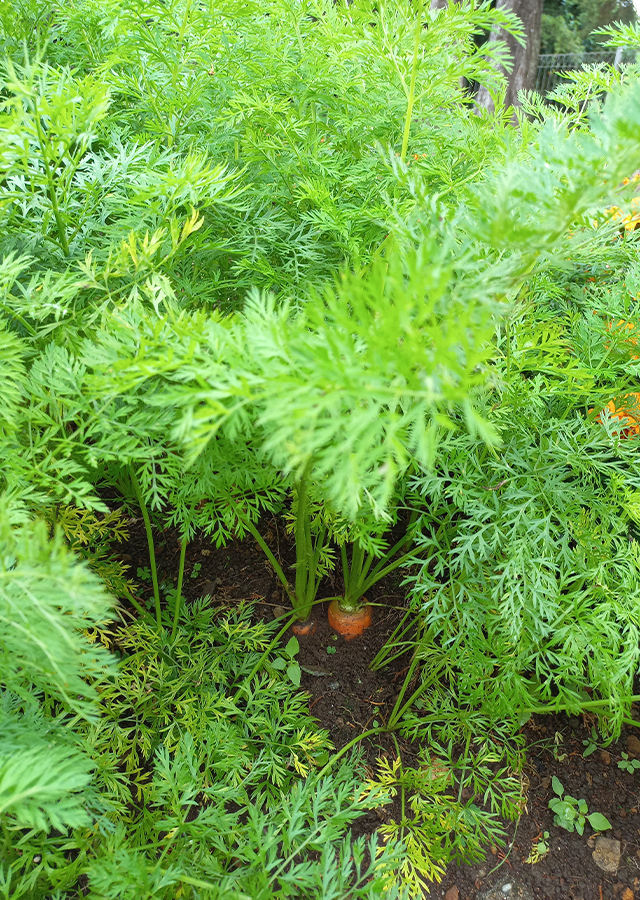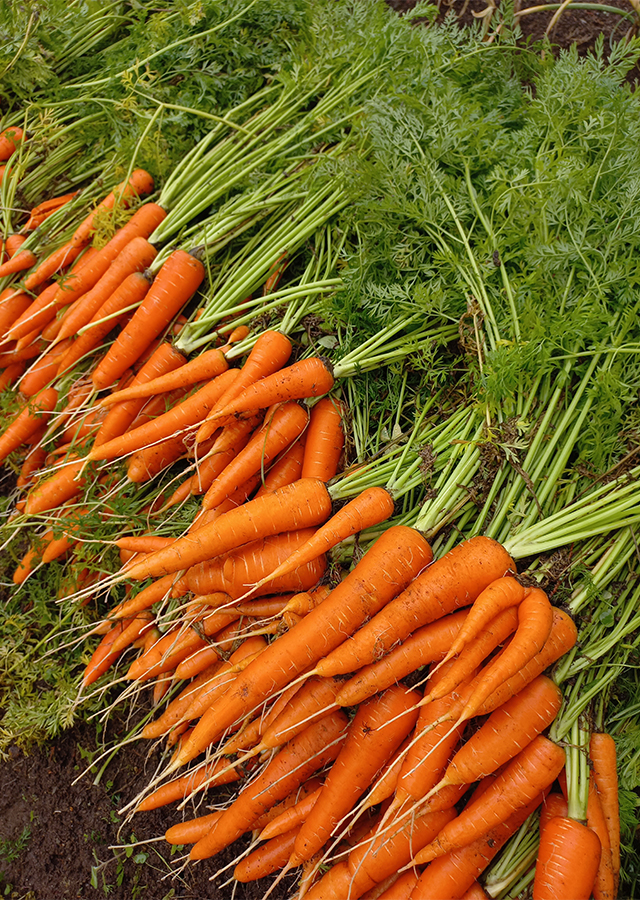Carrot
Daucus carota L.
Apiaceae
Location in our garden
Vegetable



Synonym
Caucalis carota (L.) Crantz
Habitus
Herbaceous. Annual or biennial erect herb, 20-50 cm tall at the mature vegetative stage and 120-150 cm tall when flowering
Part Used
Seeds
Roots
Growing Requirements
Full Sunshine
Habitat
Coastal
Roadside
Shrublands
Grassland
Terrestrial
Overview
Daucus carota is native to Europe, southwestern Asia and North Africa, and is naturalized in North America, Japan, New Zealand and Australia. It was probably introduced to North America from Europe as a weed seed contaminant in imported grain by the earliest colonists in the early 17th century. It is harvested from the wild for local use as a food, medicine and source of materials. It is one of the most popular vegetables worldwide. The swollen taproot of carrot is eaten and is an important market vegetable, even in tropical areas. The roots are consumed raw or cooked, alone or in combination with other vegetables (for example, peas). Carrots are often canned, dehydrated, or quick frozen. Large quantities are also processed into infant food, juice or as an ingredient of soups, sauces, salads and stews. Young leaves are sometimes eaten raw or are also used as fodder. An essential oil from the seed is used as a food flavouring.
Vernacular Names
Zanahoria (Spanish), Carotte (French), Wilde wortel (Dutch), Karotten (German), Gazar (Arabic), Ye hu luo bo (Chinese), Ninjin (Japanese), Khaerot (Thai), Cà rốt (Vietnamese), Lobak merah (Malay), Karot (Tagalog-Philippines).
Agroecology
Carrot can be found growing in rough grassland, along coastal cliffs and in dunes, as well as in overgrown thickets, weedy meadows, along railroads and roadsides, abandoned fields, degraded prairies and waste lands. Prefers a good light warm well-drained soil and plenty of moisture, and a sandy or calcareous loam. Plants are extremely sensitive to soil conditions, good roots can only be produced in a soil that permits easy penetration of the root. Carrots are reported to tolerate an annual precipitation in the range of 31 to 410 cm, an annual temperature range of 3.6 to 28.5 °C and a pH of 4.2 to 8.7. Grows best with a pH in the range 6.5 to 7.5.
Morphology
- Root - taproot thickened, fleshy, straight, conical to cylindrical, orange (most common), reddish-violet, yellow or white; the core (xylem) of mature roots is usually somewhat lighter in colour than the phloem, and the top of the root is often green.
- Leaves - growing in a rosette, glabrous, green, 8-12, with long petiole often sheathed at its base; leaf-blade 2-3-pinnate, the segments divided into often linear ultimate lobes.
- Flower - flowering stalks few to several, branched, each branch ending in a compound umbel (inflorescence); each umbel comprising 50 or more umbellets, primary rays 2-25 cm, secondary rays 1-6 cm, pedicels 0.5-1.5 cm long; flowers mainly bisexual in primary umbels, in umbels of higher order an increasing number of male flowers may occur in addition to bisexual flowers; a few purple-red sterile flowers may be present in the central umbellets, especially in wild plants; flower small, 2 mm in diameter, epigynous, white, 5-merous but with 2 carpels and 2 styles.
- Fruit - an oblong-ovoid schizocarp, 2-4 mm long, at maturity splitting into 2 mericarps, primary ridges ciliate, secondary ridges with hooked spines.
- Seed - inside the mericarp with a long embryo embedded in endosperm.
Cultivation
Generative propagation is by seed - sow in situ in succession from early spring to early summer. Do not transplant the seedlings, since this will usually cause damage to the roots and a good crop will not be obtained. Carrot seed needs a well-made seed bed with a fine tilth if good germination is to be achieved. The earliest sowings can be made of an early maturing variety in a cold frame or greenhouse in January or late winter, this will provide edible roots in late spring. The first outdoor sowings are made as the soil warms up in the spring. Successional sowings can be made until early summer if required. A September sowing in mild areas can provide an early spring supply of young roots, though the plants will often require some protection.
Chemical Constituents
Essential oils (α-pinene, sabinene, germacrene D, geranyl acetate, sedrone S and azarone E), volatile oils (pyrrolidine, daucine, mannitelucose, malic acid, pectin, asparagine, inosite, carotin, lecithin, phosphatide, glutamine, etc.), alkaloid, flavonoid, saponin, tannin, polyphenol, glucoside, sesquiterpenes (carotol, daucene, trans-α-bergamotene, trans-ß-farnesene, ß-bisabolene, ß-himachalene).
Traditional Medicinal Uses
- In Mexico, roots are boiled in milk and used for coughs and chest affliction.
- When used as a regular item in the diet the roots improve eyesight and skin health, and also have anti-cancer effects.
- Poultice of carrots is used for ulcers, carbuncles, infected wounds.
- Seeds of the plant when ground to powder and taken as tea for colic and to increase urine flow.
- Tea of carrot blossoms has been used for treatment of dropsy.
- In India, seeds as considered a nervine tonic. Decoction of leaves and seeds is used as stimulant to the uterus during parturition. In the Punjab, seeds are used as aphrodisiac and used for uterine pain. Fruit is recommended for chronic diarrhea. Seeds are also used as abortifacient.
- In European folk medicine, root decoction is used for jaundice and hepatic disorders.
Part Used
Reference Sources
- CAB International. (2022). Invasive Species Compendium: Daucus carota (carrot). https://www.cabi.org/isc/datasheet/18018#toPictures. 05-02-2022.
- Fern, Ken. (2021). Useful Temperate Plants Database: Daucus carota sativus. https://temperate.theferns.info/plant/Daucus+carota+sativus. 05-02-2022.
- Kew Royal Botanical Gardens. (2021). Plants of the World Online: Daucus carota L. https://powo.science.kew.org/taxon/urn:lsid:ipni.org:names:841063-1. 05-02-2022.
- National Park of Singapore. (2021). Flora Fauna Web: Daucus carota subsp. sativus. https://www.nparks.gov.sg/florafaunaweb/flora/5/9/5923. 05-02-2022.
- Stuartxchange. (2020). Philippine Medicinal Plants: Karot. http://www.stuartxchange.org/Karot. 05-02-2022.


